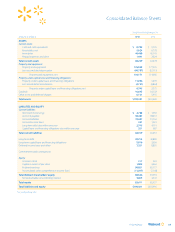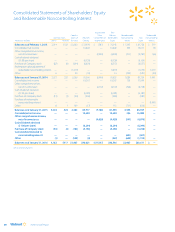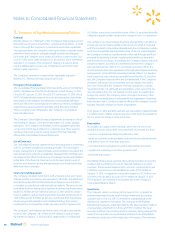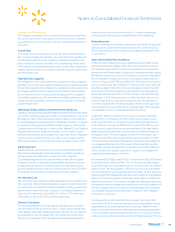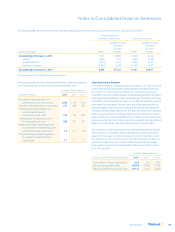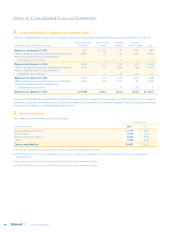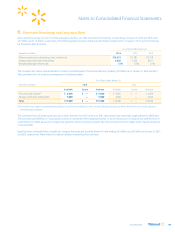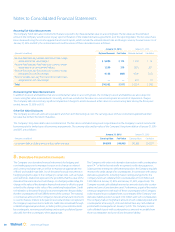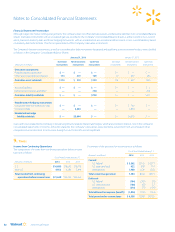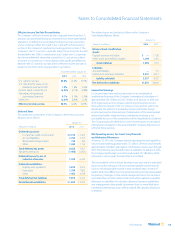Walmart 2016 Annual Report Download - page 45
Download and view the complete annual report
Please find page 45 of the 2016 Walmart annual report below. You can navigate through the pages in the report by either clicking on the pages listed below, or by using the keyword search tool below to find specific information within the annual report.
43Only Walmart
Financial and Other Services
The Company recognizes revenue from service transactions at the time
the service is performed. Generally, revenue from services is classified
as a component of net sales in the Company’s Consolidated Statements
of Income.
Cost of Sales
Cost of sales includes actual product cost, the cost of transportation to
the Company’s distribution facilities, stores and clubs from suppliers, the
cost of transportation from the Company’s distribution facilities to the
stores, clubs and customers and the cost of warehousing for the Sam’s
Club segment and import distribution centers. Cost of sales is reduced by
supplier payments that are not a reimbursement of specific, incremental
and identifiable costs.
Payments from Suppliers
The Company receives consideration from suppliers for various programs,
primarily volume incentives, warehouse allowances and reimbursements
for specific programs such as markdowns, margin protection, advertising
and supplier-specific fixtures. Payments from suppliers are accounted
for as a reduction of cost of sales and are recognized in the Company’s
Consolidated Statements of Income when the related inventory is sold,
except when the payment is a reimbursement of specific, incremental
and identifiable costs.
Operating, Selling, General and Administrative Expenses
Operating, selling, general and administrative expenses include all operating
costs of the Company, except cost of sales, as described above. As a result,
the majority of the cost of warehousing and occupancy for the Walmart
U.S. and Walmart International segments’ distribution facilities is included
in operating, selling, general and administrative expenses. Because the
Company does not include most of the cost of its Walmart U.S. and Walmart
International segments’ distribution facilities in cost of sales, its gross
profit and gross profit as a percentage of net sales may not be comparable
to those of other retailers that may include all costs related to their
distribution facilities in cost of sales and in the calculation of gross profit.
Advertising Costs
Advertising costs are expensed as incurred, consist primarily of print,
television and digital advertisements and are recorded in operating,
selling, general and administrative expenses in the Company’s
Consolidated Statements of Income. Reimbursements from suppliers
that are for specific, incremental and identifiable advertising costs are
recognized as a reduction of advertising costs in operating, selling,
general and administrative expenses. Advertising costs were $2.5 billion
for fiscal 2016 and $2.4 billion for both fiscal 2015 and fiscal 2014.
Pre-Opening Costs
The cost of start-up activities, including organization costs, related to new
store openings, store remodels, relocations, expansions and conversions
are expensed as incurred and included in operating, selling, general and
administrative expenses in the Company’s Consolidated Statements
of Income. Pre-opening costs totaled $271 million, $317 million and
$338 million for fiscal 2016, 2015 and 2014, respectively.
Currency Translation
The assets and liabilities of all international subsidiaries are translated
from the respective local currency to the U.S. dollar using exchange rates
at the balance sheet date. Related translation adjustments are recorded
as a component of accumulated other comprehensive income (loss).
The income statements of all international subsidiaries are translated
from the respective local currencies to the U.S. dollar using average
exchange rates for the period covered by the income statements.
Reclassifications
Certain reclassifications have been made to previous fiscal year amounts
and balances to conform to the presentation in the current fiscal year.
These reclassifications did not impact consolidated operating income
or net income.
Recent Accounting Pronouncements
In May 2014, the Financial Accounting Standards Board (“FASB”) issued
Accounting Standards Update (“ASU”) 2014-09, Revenue from Contracts
with Customers (Topic 606). This ASU is a comprehensive new revenue
recognition model that requires a company to recognize revenue to depict
the transfer of goods or services to a customer at an amount that reflects
the consideration it expects to receive in exchange for those goods or
services. In August 2015, FASB issued ASU 2015-14, Revenue from Contracts
with Customers (Topic 606): Deferral of the Effective Date, which deferred
the effective date of ASU 2014-09 to reporting periods beginning after
December 15, 2017. Early adoption is permitted for reporting periods
beginning after December 15, 2016. The Company will adopt this ASU
on February 1, 2018. Companies may use either a full retrospective or a
modified retrospective approach to adopt this ASU. Management is
currently evaluating this standard, including which transition approach
to use, and does not expect this ASU to materially impact the Company’s
consolidated net income, financial position or cash flows.
In April 2015, FASB issued ASU 2015-03, Interest-Imputation of Interest
(Subtopic 835-30): Simplifying the Presentation of Debt Issuance Cost.
FASB issued ASU 2015-03 to simplify the presentation of debt issuance
costs related to a recognized debt liability to present the debt issuance
costs as a direct deduction from the carrying value of the debt liability
rather than showing the debt issuance costs as a deferred charge on
the balance sheet. The new guidance is effective for fiscal years and
interim periods within those years beginning after December 15, 2015,
with early adoption permitted. Management elected to early adopt this
new guidance effective for the first quarter of fiscal year 2016, and has
applied the changes retrospectively to all periods presented. Adoption
of this ASU did not materially impact the Company’s consolidated net
income, financial position or cash flows.
In November 2015, FASB issued ASU 2015-17, Income Taxes (Topic 740): Balance
Sheet Classification of Deferred Taxes. This ASU requires the presentation
of all deferred tax assets and liabilities as non-current in the consolidated
balance sheet. The new guidance is effective for fiscal years and interim
periods within those years beginning after December 15, 2016, with early
adoption permitted. Management elected to early adopt this new guidance
effective for the fourth quarter of fiscal year 2016 in order to simplify the
global close processes. The Company will apply the changes prospectively.
Prior periods were not retrospectively adjusted to reflect the adoption of
this ASU. Adoption of this ASU did not materially impact the Company’s
consolidated financial position, and had no impact on the Company’s
net income or cash flows.
In February 2016, FASB issued ASU 2016-02, Leases (Topic 842). FASB
issued ASU 2016-02 to increase transparency and comparability among
organizations by recognizing lease assets and lease liabilities on the
balance sheet and disclosing key information about leasing arrangements.
Certain qualitative and quantitative disclosures are required, as well as
a retrospective recognition and measurement of impacted leases. The new
Notes to Consolidated Financial Statements






